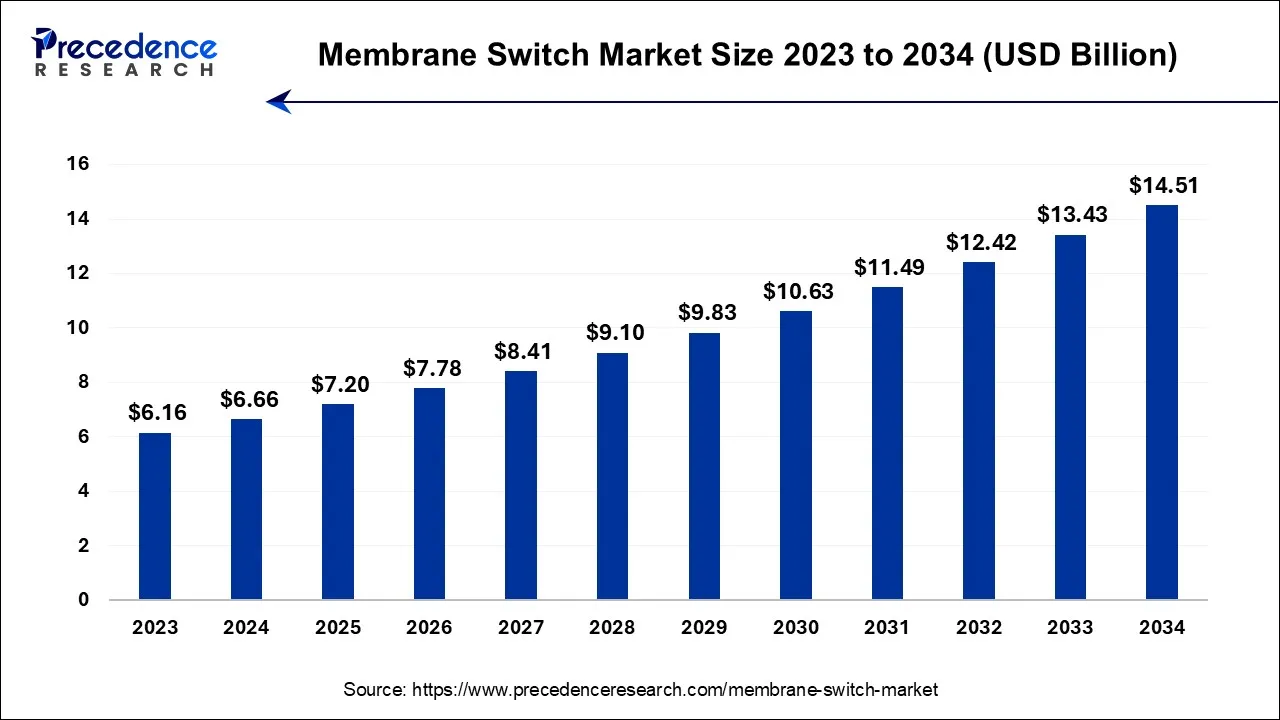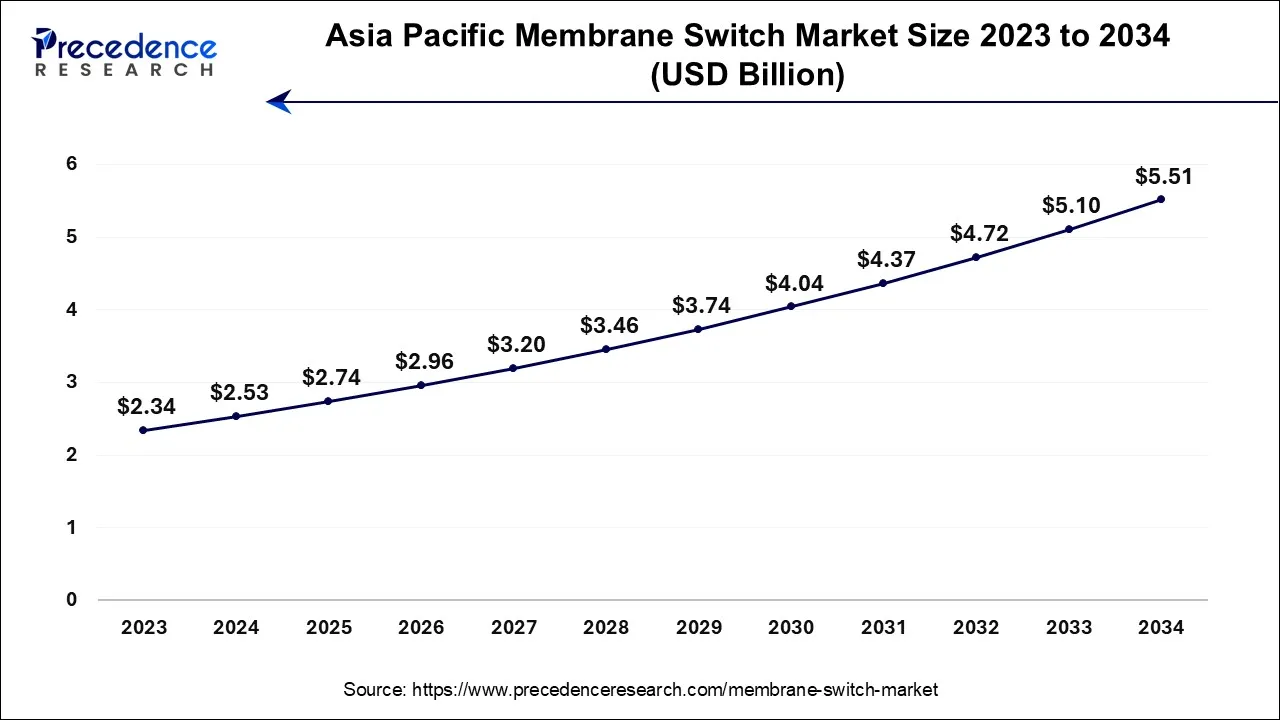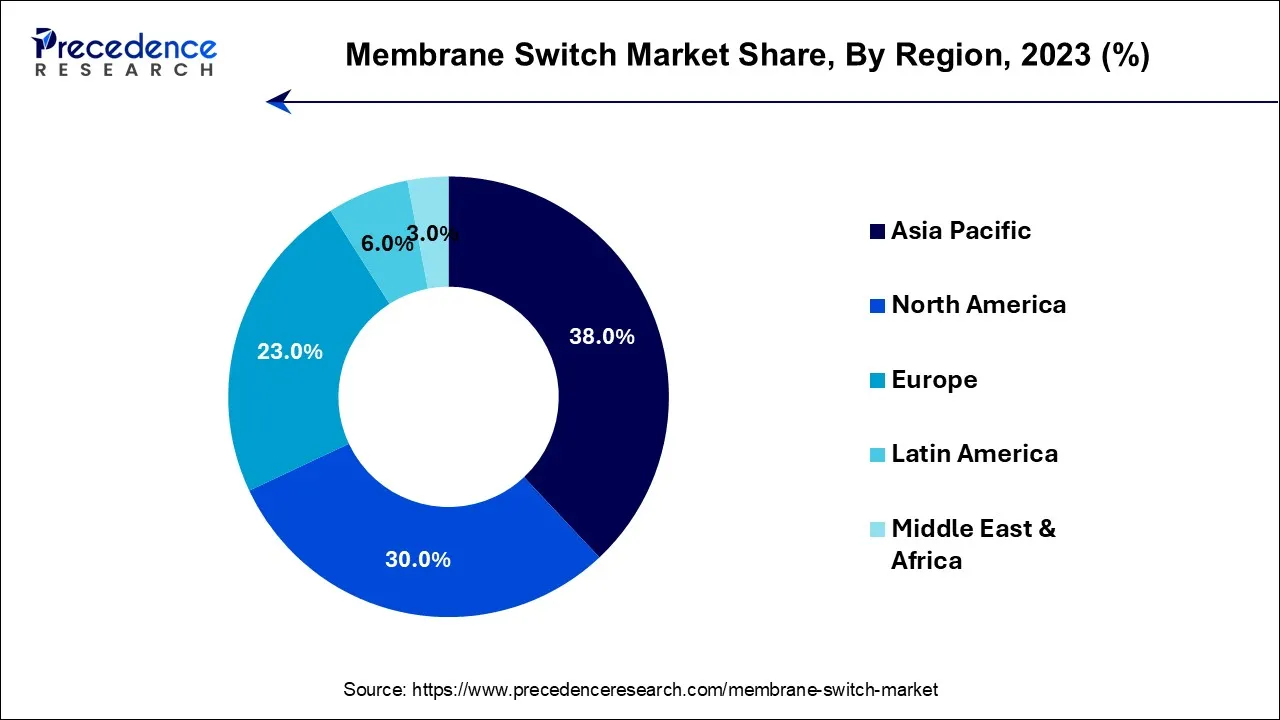The global membrane switch market size accounted for USD 6.66 billion in 2024, grew to USD 7.20 billion in 2025 and is projected to surpass around USD 14.51 billion by 2034, representing a healthy CAGR of 8.1% between 2024 and 2034. The Asia Pacific membrane switch market size is calculated at USD 2.53 billion in 2024 and is expected to grow at a fastest CAGR of 8.2% during the forecast year.
The global membrane switch market size is calculated at USD 6.66 billion in 2024 and is predicted to hit around USD 14.51 billion by 2034 growing at a CAGR of 8.1% from 2024 to 2034.

The Asia Pacific membrane switch market size is exhibited at USD 2.53 billion in 2024 and is projected to be worth around USD 5.51 billion by 2034, growing at a CAGR of 8.3% from 2024 to 2034.

Asia Pacific held the largest revenue share at 38% in 2023. Asia Pacific, in the context of the membrane switch market, encompasses a dynamic and rapidly growing region that includes countries like China, India, Japan, and South Korea. This region has witnessed substantial market expansion due to the flourishing electronics manufacturing industry. The demand for sleek and user-friendly interfaces in consumer electronics, combined with the increased adoption of membrane switches in industrial machinery, has contributed to its growth. Additionally, the rising emphasis on smart devices and energy-efficient solutions in Asia Pacific has fueled the adoption of membrane switches, aligning with global industry trends.

Europe is estimated to observe the fastest expansion. Europe encompasses a diverse region consisting of numerous countries with varying industrial sectors. A notable trend in this region is the increasing adoption of membrane switches in healthcare applications, driven by the demand for hygienic and easy-to-clean interfaces in medical devices.
Additionally, the automotive industry in Europe is integrating membrane switches for vehicle controls, emphasizing their cost-effectiveness and reliability. The European market is also witnessing growth in environmental control systems, where the resistance of membrane switches to dust and moisture is advantageous, aligning with the region's increasing focus on sustainability and energy efficiency.
A membrane switch is a user interface or input device commonly used in electronic equipment and control panels. It consists of multiple layers of flexible materials, typically including a top graphic overlay, a spacer or membrane layer, and a bottom circuit layer. When a user presses a specific area on the graphic overlay, it causes the top layer to flex and make contact with the circuit layer beneath, completing an electrical circuit. This momentary switch action generates a signal that can be processed by the connected electronic device, allowing for various functions like turning on a device, changing settings, or inputting data.
Membrane switches have gained widespread popularity owing to their robustness, slim design, and ability to withstand harsh environmental conditions like moisture and dust. They find extensive use in diverse sectors, including computer keyboards, remote controls, medical equipment, industrial machinery, and consumer electronics. Membrane switches offer a high degree of design versatility, enabling the incorporation of personalized graphics, backlighting, and tactile response, making them a versatile and sophisticated choice for user interfaces in a multitude of industries.
| Report Coverage | Details |
| Market Size by 2034 | USD 14.51 Billion |
| Market Size in 2024 | USD 6.16 Billion |
| Market Growth Rate from 2024 to 2034 | CAGR of 8.1% |
| Largest Market | Asia Pacific |
| Base Year | 2023 |
| Forecast Period | 2024 to 2034 |
| Segments Covered | Type, Product, Application, and Regions |
| Regions Covered | North America, Europe, Asia-Pacific, Latin America, and Middle East & Africa |
User interface demand and energy management
The membrane switch market is thriving due to the escalating demand for user-friendly interfaces in a broad spectrum of electronic devices. In response to the consumer and industrial desire for streamlined, user-centric, and robust interfaces, membrane switches have emerged as a preferred solution. Their capability to provide a seamless and highly responsive user experience is especially vital in sectors like consumer electronics, medical equipment, and industrial machinery.
Furthermore, the versatility of membrane switches, including their potential for custom graphics, backlighting, and tactile response, amplifies their appeal to manufacturers aiming to deliver superior user interfaces. The membrane switch market is also bolstered by its adoption in energy management systems. In the context of energy-efficient solutions, where precision and durability are paramount, membrane switches offer a practical solution. Their resistance to moisture and dust ensures reliable performance even in challenging environments.
As energy management becomes a critical concern worldwide, membrane switches have found a niche in this sector, contributing to increased market demand. These switches enable control and monitoring in various energy management applications, including HVAC systems and environmental control, making them a valuable component in the pursuit of efficient energy utilization.
Longevity concerns and design limitations
Longevity concerns have emerged as a notable restraint in the membrane switch market. While membrane switches are renowned for their durability, over time, their performance may deteriorate, affecting their lifespan and necessitating replacements. This concern is particularly relevant in applications where switches are subjected to heavy usage, as it could result in increased maintenance costs and downtime. Potential wear and tear, especially in industrial and high-traffic settings, could compromise the long-term reliability of membrane switches. These longevity issues underscore the need for ongoing research and development efforts to enhance the durability of these switches and address their long-term performance concerns.
Design limitations present another challenge for the membrane switch market. The inherent flexibility of membrane switches, while beneficial in many ways, can impose restrictions on design options. This can impact the overall aesthetics and functionality of the switches, especially in industries where a unique and complex user interface design is essential. Striking a balance between flexibility and design intricacy is a constant challenge, and it underscores the importance of innovation and engineering in addressing these limitations to unlock the full potential of membrane switches across diverse applications.
Specialized applications
Specialized applications are opening new avenues of opportunity in the membrane switch market. By tailoring membrane switch designs to meet the unique and stringent requirements of niche industries, manufacturers can tap into segments like marine, aviation, and military controls. These sectors demand specialized membrane switches that can withstand extreme environmental conditions, offer high levels of durability, and ensure precision in critical operations. As technology advances, there is a growing need for intricate and customized user interfaces in these areas, driving the demand for membrane switches.
Moreover, membrane switches can be adapted to meet the specific regulations and standards of these industries, making them a valuable component in specialized applications. This strategic approach allows manufacturers to carve a niche for themselves and explore untapped markets where standard user interfaces may fall short of meeting industry-specific needs.
The tactile segment held a 35% revenue share in 2023. The tactile segment in the membrane switch market pertains to switches that provide physical feedback to the user upon actuation. These switches typically feature a noticeable "click" or tactile sensation, enhancing the user experience.
A key trend in this segment is the increasing demand for responsive and tactile switches, especially in applications where users require confirmation of input. This trend is particularly prominent in industries like gaming and automotive, where precise and tangible feedback is crucial for user satisfaction. Manufacturers are continually innovating to develop membrane switches with improved tactile feedback to cater to these evolving user expectations.
The PCB backed segment is anticipated to expand at a significant CAGR of 9.2% during the projected period. PCB-backed segment within the membrane switch market, feature a printed circuit board (PCB) as a supportive layer beneath the switch. This construction enhances durability and robustness.
A notable trend in this segment is the growing demand for PCB-backed membrane switches in applications requiring higher reliability and extended lifespan. Industries such as aerospace, medical devices, and industrial control systems are increasingly adopting this type due to its ability to withstand rigorous conditions and provide a more stable electrical connection. As technology advances, the PCB-backed membrane switch segment continues to evolve, offering even greater reliability and versatility in various demanding environments.
The polyester segment had the highest market share of 45% in 2023. The polyester segment in the membrane switch market refers to the type of material used for the top graphic overlay of the switch. Polyester overlays are known for their durability, chemical resistance, and ability to withstand environmental factors, making them a popular choice. Trends in this segment involve the continuous improvement of polyester materials, resulting in increased longevity and enhanced performance of membrane switches.
Manufacturers are also focusing on developing thinner and more lightweight polyester overlays to maintain a low-profile design while offering high customization options, including intricate graphics and backlighting, to cater to the evolving demands of various industries.
The polycarbonate segment is anticipated to expand fastest over the projected period. The polycarbonate segment in the membrane switch market refers to a type of membrane switch construction where the top graphic overlay is typically made of polycarbonate material. These overlays are favored for their impressive resistance to wear and tear, chemicals, and sunlight, making them a durable choice. In recent trends, the use of polycarbonate overlays is growing due to their ability to provide long-lasting, high-quality graphics, especially in demanding environments. As industries require more robust and visually appealing user interfaces, the polycarbonate segment is gaining prominence, offering a balance between durability and aesthetics in membrane switch design.
The industrial segment had the highest market share of 41% in 2023. In the membrane switch market, the industrial segment encompasses the use of membrane switches in various industrial machinery and equipment, including control panels, manufacturing machines, and process control systems. These switches offer durability, resistance to environmental factors, and customization, making them essential for industrial applications.
A notable trend in this segment is the increasing integration of membrane switches into industrial automation and IoT systems. This enhances efficiency and control, reducing manual labor and minimizing downtime. Additionally, industries are progressively adopting more advanced materials and design innovations to ensure the longevity and reliability of membrane switches in demanding industrial environments.
The medical segment is anticipated to expand fastest over the projected period. In the membrane switch market, the medical segment refers to the use of these switches in various medical applications, including diagnostic equipment, patient monitoring devices, and medical instruments. A notable trend in this field involves a growing need for clean and easily maintainable membrane switches, given the crucial importance of hygiene and infection prevention in healthcare.
Furthermore, the surge in membrane switch adoption is spurred by their dependability and suitability for medical devices, aligning with the broader trend of incorporating these switches into advanced medical equipment. This integration enhances user interaction and control, ultimately benefiting patient care and medical practices.
Segments Covered in the Report
By Type
By Product
By Application
By Geography
For inquiries regarding discounts, bulk purchases, or customization requests, please contact us at sales@precedenceresearch.com
No cookie-cutter, only authentic analysis – take the 1st step to become a Precedence Research client